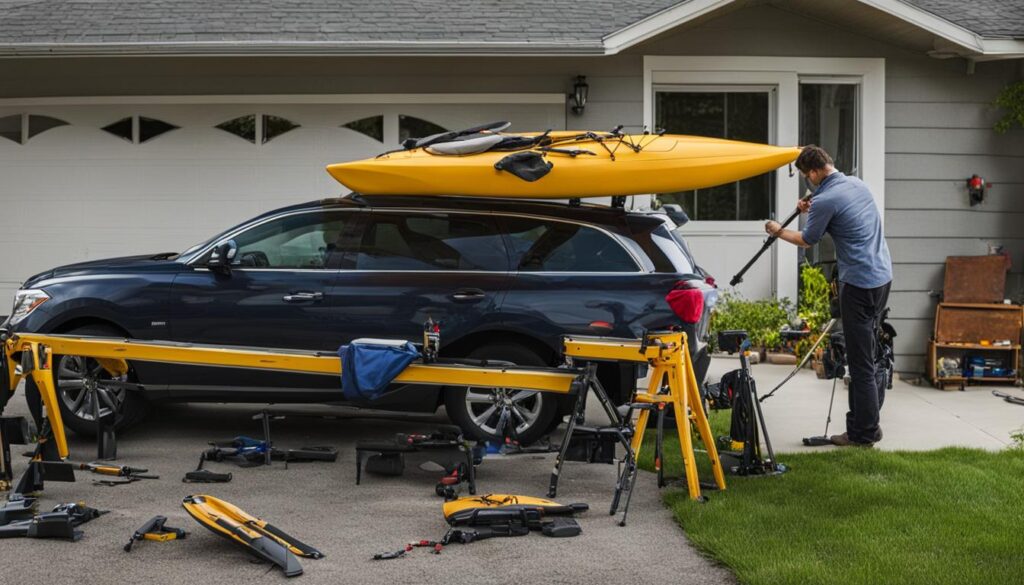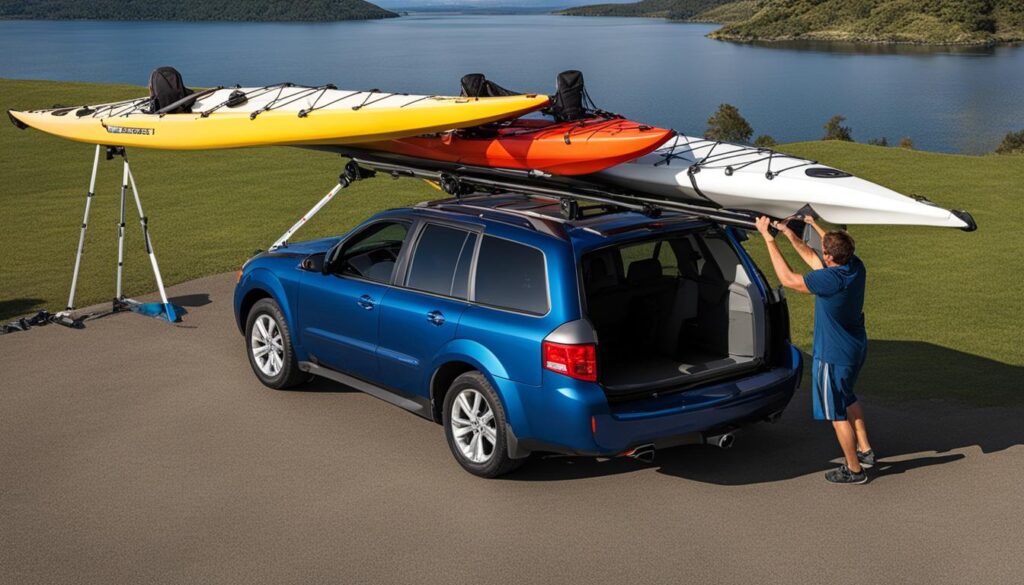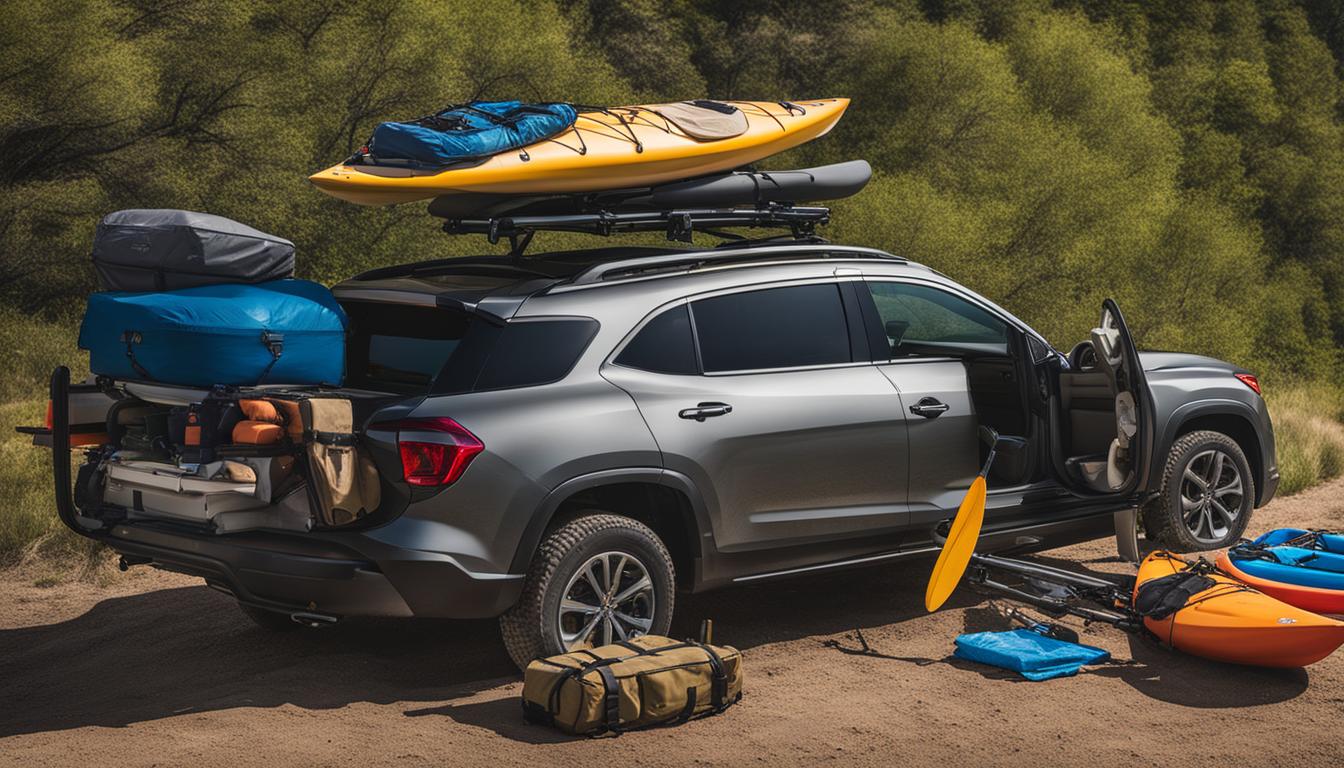For outdoor enthusiasts who enjoy kayaking, having a reliable and efficient kayak storage solution is a must. EZTube, the global supplier of advanced commercial and industrial framing solutions, offers versatile and easy-to-use kayak racks that simplify kayak storage and transportation. With customizable design options and space-saving benefits, EZTube kayak racks help maximize vehicle space for efficient and hassle-free kayak transport.
Key Takeaways:
- Maximizing space for kayak transport is crucial for efficient and hassle-free adventures.
- EZTube kayak racks offer customizable design options and space-saving benefits.
- Choose the right kayak rack that is compatible with your vehicle’s roof type.
- Proper installation and preparation of your vehicle are essential for a secure kayak rack.
- Practice proper techniques when loading, unloading, and securing your kayak.
Why Choose EZTube Kayak Racks?
EZTube kayak racks offer several advantages for secure and efficient kayak storage and transportation. With their customizable design options and space-saving benefits, EZTube kayak racks are the perfect solution for maximizing vehicle space. Here’s why you should choose EZTube:
- Secure Kayak Storage: EZTube kayak racks provide secure and stable storage, ensuring that your kayak is safe and protected during transport.
- Customizable Design: The racks are customizable to fit the dimensions of your kayak, ensuring a perfect fit and maximum efficiency.
- Space-Saving Solution: EZTube kayak racks help you maximize your vehicle’s storage capacity, making every inch count for efficient kayak transportation.
- Easy Kayak Access: The user-friendly design features of EZTube kayak racks make it quick and easy to access your kayak whenever you’re ready for an adventure.
- Durable Construction: EZTube kayak racks are made from high-quality aluminum, providing long-lasting performance and resistance to various weather conditions.
Choose EZTube kayak racks for secure and customizable kayak storage, space-saving solutions, easy kayak access, and durability. With EZTube, you can enjoy hassle-free and efficient kayak transportation.
| EZTube | Competitor A | Competitor B | |
|---|---|---|---|
| Secure Storage | ✔️ | ❌ | ✔️ |
| Customizable Design | ✔️ | ❌ | ❌ |
| Space-Saving | ✔️ | ❌ | ✔️ |
| Easy Access | ✔️ | ✔️ | ❌ |
| Durable Construction | ✔️ | ✔️ | ✔️ |
Table: Comparison of EZTube kayak racks with competitors. EZTube outshines its competitors with its secure storage, customizable design, space-saving features, easy access, and durable construction.
Choosing the Right Kayak Rack for Your Vehicle
When it comes to transporting your kayak safely and efficiently, choosing the right kayak rack for your vehicle is crucial. Here are some factors to consider:
- Compatible Kayak Rack: Ensure that the kayak rack you choose is compatible with your vehicle’s roof type. Different roof types require different rack systems, so make sure to select one that fits securely.
- Weight Capacity: Check the weight capacity of the kayak rack to ensure it can safely support your kayak(s) and any additional gear you may have. It’s important not to exceed the weight limit to prevent any damage to your vehicle or the rack itself.
- Storage Options: Evaluate your storage needs and determine whether you require a rack for a single kayak or multiple kayaks. Some racks offer additional storage options for gear or accessories, providing added convenience.
- Versatile Rack: Look for a kayak rack that offers versatility in terms of adjustability and compatibility with various accessories. This allows you to customize the rack based on your specific requirements.
- Accessory Compatibility: Consider if you plan to use additional accessories such as kayak carriers, bike mounts, or cargo boxes. Ensure that the kayak rack you choose is compatible with these accessories to maximize functionality and convenience.
By taking into account these factors, you can select a kayak rack that suits your vehicle and storage needs, providing a secure and efficient solution for transporting your kayak.
Now that you have a better understanding of what to consider when choosing a kayak rack, let’s move on to the proper installation and preparation of your vehicle in the next section.
Proper Installation and Preparing Your Vehicle for Kayak Rack
Before you can enjoy hassle-free kayak transportation, it’s crucial to properly install and prepare your vehicle for the kayak rack. Following these steps will ensure a smooth and secure setup for your adventures.
Step 1: Clean and Inspect Your Vehicle’s Roof
Before installing the kayak rack, thoroughly clean and inspect your vehicle’s roof to ensure a smooth and secure installation. Remove any dirt, grime, or debris that may hinder the rack’s attachment. This will help to ensure a strong and stable base for your kayak rack.
Step 2: Measure and Mark the Placement
Take accurate measurements of your vehicle’s roof and the kayak rack to determine the optimal placement. Mark the positions where the rack will be attached, ensuring proper alignment and balance. This step is crucial for both the stability of the rack and the safety of your kayak during transportation.
Step 3: Gather Necessary Tools
Before starting the installation process, gather all the necessary tools and equipment. This may include a wrench, screwdriver, measuring tape, and any additional hardware provided with the kayak rack. Having all the tools on hand will make the installation process more efficient and streamlined.
Step 4: Remove Obstacles
Ensure there are no obstacles or obstructions on your vehicle’s roof that may interfere with the installation of the kayak rack. Remove any existing roof racks, bike mounts, or other accessories that may hinder the proper attachment of the kayak rack. Clearing the roof of any obstacles will ensure a secure and stable fit for your kayak rack.

| Step | Actions |
|---|---|
| 1 | Clean and inspect your vehicle’s roof |
| 2 | Measure and mark the placement |
| 3 | Gather necessary tools |
| 4 | Remove obstacles |
By following these preparation steps, you can ensure a successful installation of your kayak rack, providing a secure and efficient solution for transporting your kayak to your next adventure.
Step-By-Step Installation Guide for Kayak Racks
Proper installation of your kayak rack is crucial to ensure the safety and security of your kayak during transportation. By following these step-by-step instructions, you can confidently assemble and secure your kayak rack to your vehicle.
1. Read the Manufacturer’s Instructions
Before starting the installation process, carefully read and familiarize yourself with the manufacturer’s instructions. Each kayak rack may have specific requirements and guidelines that you need to follow for proper installation and use. Take the time to understand the instructions thoroughly before proceeding.
2. Assemble the Rack Components
Gather all the components of your kayak rack and assemble them according to the manufacturer’s instructions. This may involve attaching bars, brackets, or other necessary parts. Ensure that all components are securely connected and tightened to prevent any loosening or damage during transportation.
3. Secure the Rack to Your Vehicle
Using the provided hardware and recommended tightening torque, secure the kayak rack to your vehicle. Follow the manufacturer’s instructions to determine the proper attachment points on your vehicle and ensure a secure fit. Double-check that all bolts and screws are tightened properly to prevent any movement or shifting of the rack.
4. Adjust and Secure Straps
Once the rack is securely attached to your vehicle, adjust the straps or tie-downs to fit your kayak. Position the kayak on the rack, ensuring that it is centered and balanced. Securely fasten the straps or tie-downs, making sure they are tight enough to hold the kayak in place but not overly tightened, as this could damage the kayak.
5. Ensure Stability and Security
Before hitting the road, thoroughly inspect your kayak rack to ensure stability and security. Wiggle the rack to check for any loose connections or movement. Give the kayak a gentle shake to ensure it is securely held in place. If necessary, use additional straps or tie-downs to further enhance the stability and security of the kayak and rack.
| Step | Instructions |
|---|---|
| 1 | Read the manufacturer’s instructions |
| 2 | Assemble the rack components |
| 3 | Secure the rack to your vehicle |
| 4 | Adjust and secure straps |
| 5 | Ensure stability and security |
Following these step-by-step instructions will help you properly install your kayak rack and ensure a safe and secure journey for your kayak. By taking the time to assemble the rack correctly, secure it tightly to your vehicle, and adjust the straps properly, you can enjoy worry-free transportation of your kayak to your next adventure.
Tips for Loading and Unloading Your Kayak
Loading and unloading your kayak can be a breeze with the right techniques and tools. Follow these tips to ensure a smooth and hassle-free process.
Proper Lifting Techniques
When lifting your kayak, it’s important to use proper techniques to avoid strain or injury. Start by standing with your feet shoulder-width apart, ensuring a stable base. Bend at your knees, keeping your back straight, and lift the kayak using your leg muscles. Avoid bending your back or using your arms to lift the kayak, as this can lead to back injuries. If your kayak is heavy or awkward to lift, consider enlisting the help of another person to share the load.
Use Kayak Loading Assist Tools
To make the loading and unloading process even easier, consider using kayak loading assist tools. These tools are designed to help slide the kayak onto the rack or lift it onto your vehicle. Kayak loading bars or slide-out extensions can provide a smooth surface to slide the kayak onto the rack without straining your back. These tools can be particularly useful if you’re loading the kayak onto a higher vehicle or if you have limited upper body strength.
Getting Help
If you’re finding it difficult to load or unload your kayak on your own, don’t hesitate to ask for help. Having a second person to assist can make the process much easier and safer. They can help guide the kayak onto the rack or provide extra support while you lift. With an extra set of hands, you can ensure that the kayak is properly positioned and secure on the rack.
Correct Positioning of Kayak
When loading your kayak onto the rack, make sure it is positioned correctly for secure transport. Center the kayak on the rack and align it with the vehicle’s roof. Ensure that the kayak is securely placed on the rack’s padding or cradles, with no overhang or instability. Double-check that the straps or tie-downs are properly adjusted and tight to hold the kayak in place. Taking the time to position your kayak correctly will prevent movement during transport and ensure a safe journey.

Protecting Your Kayak During Transportation
When it comes to transporting your kayak, it’s crucial to take proper precautions to protect your valuable equipment. Whether you’re heading to a local lake or embarking on a cross-country adventure, implementing a few key measures can go a long way in ensuring the safety and longevity of your kayak. Here are some essential tips to keep in mind:
Protective Padding and Covers
To prevent scratches, dents, and other damage during transportation, it’s essential to use protective padding and covers for your kayak. Invest in high-quality foam padding or specialized kayak covers that offer cushioning and impact resistance. These protective accessories create a buffer between your kayak and the contact points on your racks or straps, minimizing the risk of cosmetic or structural damage.
Avoid Over-Tightening Straps
While it’s crucial to secure your kayak firmly during transportation, it’s equally important to avoid over-tightening the straps. Excessive tension can put unnecessary stress on your kayak, potentially causing deformation or even structural failure over time. Instead, aim for a snug fit that keeps your kayak in place without placing excessive pressure on its hull. Regularly inspect the straps during stops to ensure they remain secure and appropriately tensioned.
Secure Loose Accessories
Before hitting the road, ensure that all loose accessories, such as paddles, life jackets, or fishing gear, are properly secured to your kayak. Use additional straps or bungee cords to keep these items in place and prevent them from becoming loose or falling off during transit. This not only protects your accessories from getting lost or damaged but also prevents any potential hazards on the road.
Inspect Tie-Downs Regularly
Regularly inspecting and maintaining your tie-downs is crucial to ensure their effectiveness and reliability. Check for any signs of wear, fraying, or degradation in the straps and buckles. If you notice any issues, replace the tie-downs immediately to ensure your kayak remains securely fastened throughout your journey. Remember, your equipment’s safety is paramount, and proper maintenance can help prevent any accidents or mishaps while on the road.
By following these tips and taking the necessary precautions, you can safeguard your kayak during transportation. From using protective padding and covers to avoid over-tightening straps, securing loose accessories, and inspecting tie-downs regularly, you’ll have peace of mind knowing that your kayak is well-protected and ready for your next adventure.
Conclusion
Maximizing space for kayak transport is crucial for efficient and hassle-free adventures. By optimizing your kayak storage and transportation, you can enhance your outdoor experiences. Choosing the right kayak rack, such as the customizable options offered by EZTube, allows you to fully utilize your vehicle’s storage capacity. These space-saving solutions provide secure and stable storage, ensuring your kayak remains protected during transport.
Proper installation and preparation of your vehicle are key factors in achieving efficient kayak transport. Take the time to clean and inspect your vehicle’s roof before installing the rack. Follow the manufacturer’s instructions carefully to ensure a secure and stable installation. Position your kayak correctly on the rack, and tighten all straps to keep it firmly in place.
During loading and unloading, practice proper lifting techniques and consider using kayak loading assist tools to make the process easier. Seeking assistance from another person can also help prevent strain or injury. Remember to protect your kayak during transportation by using padding and covers. Regularly inspect and maintain tie-downs to ensure they remain secure. By following these tips, you can enjoy stress-free and organized kayak transport.
With kayak rack optimization, efficient kayak transport, space-saving solutions, and secure kayak storage, you can embark on your outdoor adventures with ease. Make the most of your vehicle’s space and ensure the safety of your kayak by investing in the right equipment and following proper techniques. So, get ready to hit the water and enjoy the exhilaration of kayaking without any worries!
FAQ
What are the advantages of EZTube kayak racks?
EZTube kayak racks offer secure and stable storage, customizable design options, space-saving benefits, and quick and easy access to your kayak. They are also made from durable aluminum construction.
How do I choose the right kayak rack for my vehicle?
When selecting a kayak rack, consider the compatibility with your vehicle’s roof type, weight capacity, storage needs, and compatibility with accessories such as kayak carriers, bike mounts, or cargo boxes.
What do I need to do to properly install and prepare my vehicle for a kayak rack?
Thoroughly clean and inspect your vehicle’s roof, measure and mark the placement of the rack, gather the necessary tools, and remove any obstacles or obstructions that may interfere with installation.
How do I install a kayak rack step-by-step?
Start by reading and following the manufacturer’s instructions. Assemble the rack components, secure the rack to your vehicle using the provided hardware, adjust and secure the straps or tie-downs, and take additional measures for enhanced stability and security.
What are some tips for loading and unloading my kayak?
Practice proper lifting techniques, consider using kayak loading assist tools, such as kayak loading bars or slide-out extensions, and enlist the help of another person if possible. Ensure the kayak is positioned correctly on the rack and securely fastened with the straps.
How can I protect my kayak during transportation?
Use protective padding and covers to prevent scratches and damage. Avoid over-tightening the straps to prevent unnecessary stress on the kayak. Secure any loose accessories and regularly inspect and maintain tie-downs.
Can EZTube kayak racks be customized to fit different kayak sizes?
Yes, EZTube kayak racks are customizable to fit the dimensions of your kayak, ensuring a perfect fit.
Are EZTube kayak racks compatible with different roof types?
Yes, it is essential to consider the compatibility with your vehicle’s roof type when selecting an EZTube kayak rack.





